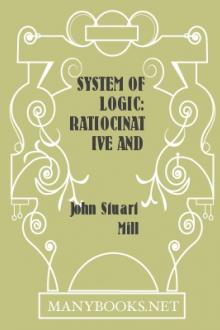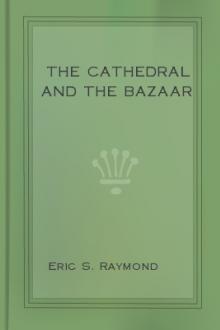A System of Logic: Ratiocinative and Inductive, John Stuart Mill [best books to read now .txt] 📗

- Author: John Stuart Mill
- Performer: -
Book online «A System of Logic: Ratiocinative and Inductive, John Stuart Mill [best books to read now .txt] 📗». Author John Stuart Mill
It must be acknowledged that there are peculiarities in the processes of arithmetic and algebra which render the theory in question very plausible, and have not unnaturally made those sciences the stronghold of Nominalism. The doctrine that we can discover facts, detect the hidden processes of nature, by an artful manipulation of language, is so contrary to common sense, that a person must have made some advances in philosophy to believe it: men fly to so paradoxical a belief to avoid, as they think, some even greater difficulty, which the vulgar do not see. What has led many to believe that reasoning is a mere verbal process, is, that no other theory seemed reconcileable with the nature of the Science of Numbers. For we do not carry any ideas along with us when we use the symbols of arithmetic or of algebra. In a geometrical demonstration we have a mental diagram, if not one on paper; AB, AC, are present to our imagination as lines, intersecting other lines, forming an angle with one another, and the like; but not so a and b. These may represent lines or any other magnitudes, but those magnitudes are never thought of; nothing is realized in our imagination but a and b. The ideas which, on the particular occasion, they happen to represent, are banished from the mind during every intermediate part of the process, between the beginning, when the premises are translated from things into signs, and the end, when the conclusion is translated back from signs into things. Nothing, then, being in the reasoner's mind but the symbols, what can seem more inadmissible than to contend that the reasoning process has to do with anything more? We seem to have come to one of Bacon's Prerogative Instances; an experimentum crucis on the nature of reasoning itself.
Nevertheless, it will appear on consideration, that this apparently so decisive instance is no instance at all; that there is in every step of an arithmetical or algebraical calculation a real induction, a real inference of facts from facts; and that what disguises the induction is simply its comprehensive nature, and the consequent extreme generality of the language. All numbers must be numbers of something: there are no such things as numbers in the abstract. Ten must mean ten bodies, or ten sounds, or ten beatings of the pulse. But though numbers must be numbers of something, they may be numbers of anything. Propositions, therefore, concerning numbers, have the remarkable peculiarity that they are propositions concerning all things whatever; all objects, all existences of every kind, known to our experience. All things possess quantity; consist of parts which can be numbered; and in that character possess all the properties which are called properties of numbers. That half of four is two, must be true whatever the word four represents, whether four hours, four miles, or four pounds weight. We need only conceive a thing divided into four equal parts, (and all things may be conceived as so divided,) to be able to predicate of it every property of the number four, that is, every arithmetical proposition in which the number four stands on one side of the equation. Algebra extends the generalization still farther: every number represents that particular number of all things without distinction, but every algebraical symbol does more, it represents all numbers without distinction. As soon as we conceive a thing divided into equal parts, without knowing into what number of parts, we may call it a or x, and apply to it, without danger of error, every algebraical formula in the books. The proposition, 2(a + b) = 2a + 2b, is a truth co-extensive with all nature. Since then algebraical truths are true of all things whatever, and not, like those of geometry, true of lines only or angles only, it is no wonder that the symbols should not excite in our minds ideas of any things in particular. When we demonstrate the forty-seventh proposition of Euclid, it is not necessary that the words should raise in us an image of all right-angled triangles, but only of some one right-angled triangle: so in algebra we need not, under the symbol a, picture to ourselves all things whatever, but only some one thing; why not, then, the letter itself? The mere written characters, a, b, x, y, z, serve as well for representatives of Things in general, as any more complex and apparently more concrete conception. That we are conscious of them however in their character of things, and not of mere signs, is evident from the fact that our whole process of reasoning is carried on by predicating of them the properties of things. In resolving an algebraic equation, by what rules do we proceed? By applying at each step to a, b, and x, the proposition that equals added to equals make equals; that equals taken from equals leave equals; and other propositions founded on these two. These are not properties of language, or of signs as such, but of magnitudes, which is as much as to say, of all things. The inferences, therefore, which are successively drawn, are inferences concerning things, not symbols; though as any Things whatever will serve the turn, there is no necessity for keeping the idea of the Thing at all distinct, and consequently the process of thought may, in this case, be allowed without danger to do what all processes of thought, when they have been performed often, will do if permitted, namely, to become entirely mechanical. Hence the general language of algebra comes to be used familiarly without exciting ideas, as all other general language is prone to do from mere habit, though in no other case than this can it be done with complete safety. But when we look back to see from whence the probative force of the process is derived, we find that at every single step, unless we suppose ourselves to be thinking and talking of the things, and not the mere symbols, the evidence fails.
There is another circumstance, which, still more than that which we have now mentioned, gives plausibility to the notion that the propositions of arithmetic and algebra are merely verbal. That is, that when considered as propositions respecting Things, they all have the appearance of being identical propositions. The assertion, Two and one are equal to three, considered as an assertion respecting objects, as for instance "Two pebbles and one pebble are equal to three pebbles," does not affirm equality between two collections of pebbles, but absolute identity. It affirms that if we put one pebble to two pebbles, those very pebbles are three. The objects, therefore, being the very same, and the mere assertion that "objects are themselves" being insignificant, it seems but natural to consider the proposition, Two and one are equal to three, as asserting mere identity of signification between the two names.
This, however, though it looks so plausible, will not bear examination. The expression "two pebbles and one pebble," and the expression, "three pebbles," stand indeed for the same aggregation of objects, but they by no means stand for the same physical fact. They are names of the same objects, but of those objects in two different states: though they denote the same things, their connotation is different. Three pebbles in two separate parcels, and three pebbles in one parcel, do not make the same impression on our senses; and the assertion that the very same pebbles may by an alteration of place and arrangement be made to produce either the one set of sensations or the other, though a very familiar proposition, is not an identical one. It is a truth known to us by early and constant experience: an inductive truth; and such truths are the foundation of the science of Number. The fundamental truths of that science all rest on the evidence of sense; they are proved by showing to our eyes and our fingers that any given number of objects, ten balls for example, may by separation and re-arrangement exhibit to our senses all the different sets of numbers the sum of which is equal to ten. All the improved methods of teaching arithmetic to children proceed on a knowledge of this fact. All who wish to carry the child's mind along with them in learning arithmetic; all who wish to teach numbers, and not mere ciphers—now teach it through the evidence of the senses, in the manner we have described.
We may, if we please, call the proposition, "Three is two and one," a definition of the number three, and assert that arithmetic, as it has been asserted that geometry, is a science founded on definitions. But they are definitions in the geometrical sense, not the logical; asserting not the meaning of a term only, but along with it an observed matter of fact. The proposition, "A circle is a figure bounded by a line which has all its points equally distant from a point within it," is called the definition of a circle; but the proposition from which so many consequences follow, and which is really a first principle in geometry, is, that figures answering to this description exist. And thus we may call "Three is two and one" a definition of three; but the calculations which depend on that proposition do not follow from the definition itself, but from an arithmetical theorem presupposed in it, namely, that collections of objects exist, which while they impress the senses thus, ooo, may be separated into two parts, thus, o o o. This proposition being granted, we term all such parcels Threes, after which the enunciation of the above mentioned physical fact will serve also for a definition of the word Three.
The Science of Number is thus no exception to the conclusion we previously arrived at, that the processes even of deductive sciences are altogether inductive, and that their first principles are generalizations from experience. It remains to be examined whether this science resembles geometry in the further circumstance, that some of its inductions are not exactly true; and that the peculiar certainty ascribed to it, on account of which its propositions are called Necessary Truths, is fictitious and hypothetical, being true in no other sense than that those propositions legitimately follow from the hypothesis of the truth of premises which are avowedly mere approximations to truth.
§ 3. The inductions of arithmetic are of two sorts: first, those which we have just expounded, such as One and one are two, Two and one are three, &c., which may be called the definitions of the various numbers, in the improper or geometrical sense of the word Definition; and secondly, the two following axioms: The sums of equals are equal, The differences of equals are equal. These two are sufficient; for the corresponding propositions respecting unequals may be proved from these, by





Comments (0)